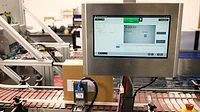Automated batching the recipe for product consistency

In the past, Blue Bell mixed much of its ice cream recipe manually, creating potential for human error. The new automation software, named Lookout, has virtually eliminated such problems by removing mechanical switches and counters from the system. Because the software automates the batching system, Blue Bell can concentrate its efforts on maintaining product quality.
Featuring object-based architecture, Lookout allows Blue Bell to control the exact percentages of fat, butter fat, milk and other ingredients the company uses to create its products. Once Lookout appropriates the correct ingredients from the control room interface to mixing tanks located on the floor, the initial mixture is blended. Using the automated production system and Lookout, Blue Bell produces three mixes at a time and can make 10 to 12 different flavors year round.

Lookout connects be-tween the Visual Basic package and PLCs for three blend room units, which draw and mix ingredients. Unit one has a single blending operation with one pasteurizing section, while the second unit controls two blending and one pasteurizing section. The third unit is a processing sequence run in manual. The PLCs are polled every three seconds, and the system responds rapidly to commands. Blue Bell can input a command in Lookout and then watch while the system responds.
While the system is running, Lookout communicates with unit one or two, directing how to adjust preset counts for meters that tie directly into PLCs. The data is then logged to a material usage database so Blue Bell can keep the proper amount of seasonal inventory. In addition, Lookout's graphic interface allows the lab to monitor all three blending operations at once. Operators use a human machine interface (HMI) to begin the process of drawing raw ingredients and mixing.
When the process is complete, operators push a confirm signal in Lookout to verify that the batch has been made. Once Lookout stamps a batch as complete, it then informs Visual Basic that the batch is made, marks the batch as complete, and queues the next batch. Blue Bell sends the interface I/O to a Visual Basic application via a dynamic data exchange (DDE) link. Visual Basic, having had mixes input by lab personnel, then prepares batches that are loaded into I/O. Next, Lookout notifies Visual Basic when batches are completed, and Visual Basic records raw material usage and completion times data for the inventory system.
Blue Bell has found that Lookout helps minimize modification to internal information systems and keeps costs low because it integrates well with other applications. With this flexibility, Blue Bell can import material usage and completion times data into an internal inventory system for easy bookkeeping updates.
On the basis of its success with Lookout in its Brenham plant, Blue Bell has begun implementing the system in its Broken Arrow, Okla., and Sylacauga, Ala., plants.
National Instruments, 11500 N. Mopac, Austin, TX 78759. Tel. (512) 794-0100.
Looking for a reprint of this article?
From high-res PDFs to custom plaques, order your copy today!





